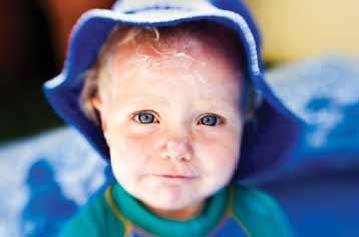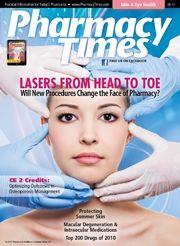Publication
Article
Pharmacy Times
Protecting Summer Skin
Author(s):
Long-term damage from ultraviolet rays can be avoided when pharmacists recommend the use of sunscreen.
Long-term damage from ultraviolet rays can be avoided when pharmacists recommend sunscreen.

When thinking about the importance of overall health, the value of one’s skin is often underestimated. According to statistics from the Skin Cancer Foundation, skin cancer is the most common form of cancer in the United States, with more than 3.5 million skin cancer cases diagnosed annually.1,2
In addition, results from studies that date back as far as the 1950s report a strong correlation between chronic, excessive, and unprotected sun exposure and carcinoma of the skin.1 Results from studies also show that an estimated 90% of nonmelanoma skin cancers are associated with excessive exposure to ultraviolet (UV) radiation from the sun and up to 90% of the visible changes commonly attributed to aging of the skin are caused by the sun.2,3 An individual’s risk of developing skin cancer may double if 5 or more episodes of sunburn are experienced.2,3
Individuals who have 1 or 2 cases of blistering sunburn during childhood may double the risk for developing skin cancer later in life.1,4 Excessive or long-term exposure to UV radiation can cause or contribute to premature aging and wrinkling of the skin (also known as photoaging).1,5 Statistics show that an estimated 50% to 80% of all photodamage will occur by 20 years of age.1
The routine use of sunscreen products is crucial in protecting the skin from both the short-term and long-term damaging effects of sun exposure. There are 2 types of UV rays that can damage the skin: UVA and UVB. UVA is primarily responsible for causing wrinkling and premature aging of the skin, whereas UVB rays are responsible for tanning, sunburn, and acceleration of skin aging, and also play a significant role in the development of skin cancer.1-4,6 The intensity of UVB rays varies by season, location or altitude, and time of day. In the United States, the peak hours for UVB rays occur between 10 am and 4 pm during the months of April and October.1-4,6
Many studies have demonstrated that when applied correctly, sunscreen products can block the majority of the sun’s harmful UV rays.1 Sunscreen products are available as lotions, creams, and sprays, and in water-resistant formulations. Products with varying sun protection factor (SPF) ranges are marketed for both the pediatric and adult populations. Sunscreens protect the skin by absorbing or reflecting UVA and UVB rays and the FDA requires that all sunscreens contain an SPF label indicating the amount of protection provided.7 The higher the SPF, the greater the protection provided (Table 1).
Table 1. Classification of SPF
SPF Range
Classification
2 to <12
Low sunburn protection
12 to <30
Medium sunburn protection
30 to ≤50
High sunburn protection
50
Highest sunburn protection
SPF = sun protection factor. Adapted from reference 1.
Risk Factors For Sunburn
Although all types of skin complexions burn, certain risk factors may put some individuals at greater risk for developing sunburn. Examples include1 :
• Individuals with fair skin
• Infants and children, if skin is unprotected, because their skin is more sensitive than adults’
• Individuals taking certain pharmacologic agents
• Individuals who use tanning beds or sun lamps
• Anyone exposed to the sun during peak hours of 10 am to 4 pm without using UV protection
Sunscreen Products
Selecting from the wide variety of sunscreen products on the market may be overwhelming for some consumers, so pharmacists should be prepared to assist patients in selecting a product that suits their individual needs. Topical sunscreen products can be divided into 2 categories—chemical and physical. Chemical sunscreens work by absorbing UV rays, thereby blocking their transmission to the epidermis, whereas physical sunscreens are typically opaque and work by reflecting and then scattering UV rays rather than absorbing them.1,5
Chemical sunscreens may contain amino benzoic acid and its derivatives, anthranilates, benzophenones, cinnamates, dibenzoylmethane derivatives, or salicylates.1,5 Physical sunscreens are often used on small areas such as the nose or tops of ears and contain zinc oxide or titanium.1,5 They are especially useful for those individuals allergic to the ingredients found in chemical sunscreens.1,5 Many products on the market contain a combination of ingredients that includes both chemical and physical sunscreens.
Sunscreens that provide protection against both UVA and UVB are referred Protecting Summer Skin to as broad-spectrum sunscreens. The American Dermatology Association recommends the use of a broad-spectrum sunscreen with an SPF of at least 30, even on cloudy days.5 Many lip balms, cosmetics, and skin moisturizers are also formulated with sunscreen protectants.
Factors that may be considered when selecting a sunscreen product include cost, skin type and complexion, reasons for using sunscreen, ease of use, formulation, SPF, history of sunburn, and medication history, because some pharmacologic agents may be associated with photosensitivity reactions.
In order to achieve optimal photoprotection, it is imperative that consumers understand how to properly apply sunscreen products. Sunscreens should be applied liberally to all exposed areas at least 15 to 30 minutes before sun exposure and reapplied as often as the product label recommends.1,7 In general, an estimated one-half teaspoon should be applied thoroughly to each exposed area to obtain adequate coverage.1,7,8 Sunscreen should be applied at least every 2 hours, especially after swimming, towel drying, or excessive sweating.5 According to the FDA, sunscreens labeled “water resistant” must maintain their SPF after 40 minutes of water immersion, whereas those labeled “very water resistant” must maintain their SPF after 80 minutes of water immersion.1,8 If an individual works outdoors, it is recommended that sunscreen should be reapplied often throughout the day.1,8,9
Table 2. Counseling Tips for Sun Protection
Always use a sunscreen product with a minimum SPF of 30 when going outdoors, even on a cloudy day.
Avoid exposure to the sun during the peak hours of 10 AM and 4 PM and stay in the shade when possible.
Wear protective eyewear during peak sun hours.
Avoid the use of tanning products or tanning beds.
Always wear protective clothing, such as long-sleeved shirts and pants, wide-brimmed hats, and sunglasses with UV protection.
Protect children from excess sun exposure by encouraging them to play in the shade, dressing them in protective clothing, and using sunscreen.
Keep infants out of the sun and in shaded areas when possible.
Routinely examine skin for any visible changes.
See your primary health care provider yearly for a professional skin exam
SPF = sun protection factor; UV = ultraviolet. Adapted from references 5, 7.
Counseling Points
During counseling, pharmacists can provide patients with pertinent information about the products available for proper photoprotection (Table 2).
Pharmacists are also key in identifying those patients at risk for possible photosensitivity reactions due to the use of certain pharmacologic agents (eg, tetracyclines, antidepressants, antihistamines, estrogens, sulfonamides, nonsteroidal anti-inflammatory drugs). These patients should be advised to always use sunscreen when going outdoors, especially for long periods.
Despite the constant reminders about avoiding overexposure to the sun, some individuals still experience sunburn because sunscreen is not always used when patients go outdoors, especially during the summer months. In addition, sun protection is equally important during the winter months, because snow reflects up to 80% of the sun’s rays and can cause sunburn and damage to exposed skin. 2,5 It is also important to remind patients about the importance of routine UV protection to protect the overall integrity and health of their skin and to reduce the chance of developing melanoma.
For a complete list of sunscreens that have earned the Skin Cancer Foundation’s seal of approval, visit the following Web site: www.skincancer.org/seal.
Table 3: Examples of Sunscreen Products
Aveeno Baby Continuous Protection Sunblock Lotion with SPF 55
Aveeno Positively Ageless Sunblock Lotion SPF for the face
Aveeno Continous Protection Sunblock Spray SPF 30
Aveeno Positively Ageless Sunblock Spray SPF 50
Aveeno Baby Natural Protection Sunblock Stick SPF50
Banana Boat Sunblock Lotion, Sport SPF 30
Banana Boat Kids Sunblock Lotion, Dri-Blok, SPF 30
Sport Performance Sunscreen SPF 85 Continuous Clear Spray
Sport Performance Sunscreen SPF 100 Continuous Clear Spray
Ultra Defense Sunscreen SPF 85 Continuous Clear Spray
Ultra Defense Sunscreen SPF 50 Continuous Clear Spray
Sport Performance Lip Balm SPF 50
Sport Performance Sunscreen SPF 50 Stick
Kids SPF 50 Sunscreen Stick
Bull Frog Sunblock, Quik Gel SPF 36
Bull Frog Quik Gel Sunblock, SPF 50
Bull Frog Ultimate Sheer Protection Sunblock for the face
Bull Frog Ultimate Sheer Protection Sunblock, SPF 30
Bull Frog Ultimate Sheer Protection Sunblock, SPF 30
Bull Frog Mosquito Coast SPF 30 Sunblock with Insect Repellent
Bull Frog Marathon Mist Continuous Spray Sunblock
Coppertone Sunblock Lotion SPF 30
Coppertone Kids Continuous Spray Sunscreen SPF 50
Coppertone SPORT Continuous Spray SPF 90
Coppertone SPORT Lotion SPF 100
Coppertone ultraGUARD Lotion SPF 90
Coppertone KIDS
Pure & Simple Sunscreen Lotion SPF 50
Hawaiian Tropic Sheer Touch Sunscreen SPF 30 Plus
Hawaiian Tropic Island Sport Clear Spray SPF 30
Hawaiian Tropic Baby Crème Lotion SPF 50
Neutrogena Ultra Sheer Dry Touch Sunblock, SPF 70
Neutrogena Sunblock Lotion, Sensitive Skin SPF 30
Neutrogena Spectrum Advanced Sunblock Face SPF 100
Neutrogena Ultimate Sport Sunblock Spray with Helioplex SPF 85 & 100
Neutrogena Ultimate Sport Spray, SPF 85 & 100
Neutrogena Age Shield Face Sunblock Lotion SPF 110
Solar Sense Clear Zinc, Advanced Sun Protection, For Face SPF 45
Solar Sense Clear Zinc Sport SPF 50 Continuous Spray
Solar Sense Clear Zinc SPF 45 Continuous Spray
Solar Sense Clear Zinc baby tear free SPF 50
Ms. Terrie is a clinical pharmacy writer based in Haymarket, Virginia
References
1. Crosby K. Prevention of sun-induced skin disorders. In: Berardi R, Newton G, McDermott JH, et al, eds. Handbook of Nonprescription Drugs. 16th ed. Washington, DC: American Pharmacists Association; 2009:729-733.
2. Skin cancer facts. Skin Cancer Foundation Web site. www.skincancer.org/Skin-Cancer-Facts/. Accessed April 9, 2011.
3. Health effects of overexposure to the sun. United States Environmental Protection Agency Web site. www.epa.gov/sunwise/uvandhealth.html.
4. Sun exposure. Medline Plus Web site. www.nlm.nih.gov/medlineplus/sunexposure.html. Accessed April 8, 2011.
5. Stoppler M. Making sense of sunscreens. Medicine.Net Web site. www.medicinenet.com/script/main/art.asp?articlekey=46376. Accessed April 9, 2011.
6. Shining light on ultraviolet radiation. Skin Cancer Foundation Web site. www.skincancer.org/shining-light-on-ultraviolet-radiation.html. Accessed April 8, 2011.
7. Sunscreens/sunblocks. The American Academy of Dermatology Web site. www.aad.org/public/publications/pamphlets/sun_sunscreens.html. Accessed April 8, 2011.
8. Facts about sunscreens. The American Academy of Dermatology Web site. www.aad.org/media/background/factsheets/fact_sunscreen.htm. Accessed April 13, 2011.
9. Sunscreen: the burning facts. The United States Environmental Protection Agency Web site. www.epa.gov/sunwise/doc/sunscreen.pdf. Accessed April 10, 2011.







